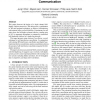Free Online Productivity Tools
i2Speak
i2Symbol
i2OCR
iTex2Img
iWeb2Print
iWeb2Shot
i2Type
iPdf2Split
iPdf2Merge
i2Bopomofo
i2Arabic
i2Style
i2Image
i2PDF
iLatex2Rtf
Sci2ools
MOBICOM
2010
ACM
2010
ACM
Achieving single channel, full duplex wireless communication
This paper discusses the design of a single channel fullduplex wireless transceiver. The design uses a combination of RF and baseband techniques to achieve full-duplexing with minimal effect on link reliability. Experiments on real nodes show the full-duplex scheme achieves a median gain of 84% in aggregate throughput as compared to traditional half-duplexing wireless for a single hop network. This paper presents using Antenna Cancellation, a novel technique for self-interference cancellation. In conjunction with existing RF interference cancellation and digital baseband intereference cancellation, antenna cancellation achieves the amount of self-interference cancellation required for fullduplex operation. The paper also discusses potential MAC and network gains with full-duplexing. It suggests ways in which a full-duplex system can solve some important problems with existing wireless systems including hidden terminals, loss of throughput due to congestion, and large end-to-end delays...
Baseband Intereference Cancellation | Communications | MOBICOM 2010 | RF Interference Cancellation | Self-interference Cancellation |
Related Content
| Added | 06 Dec 2010 |
| Updated | 06 Dec 2010 |
| Type | Conference |
| Year | 2010 |
| Where | MOBICOM |
| Authors | Jung Il Choi, Mayank Jain, Kannan Srinivasan, Philip Levis, Sachin Katti |
Comments (0)

